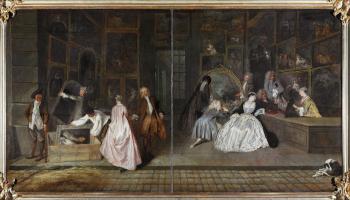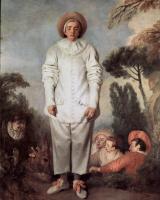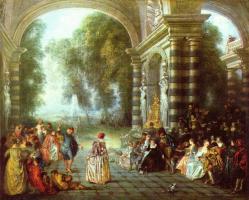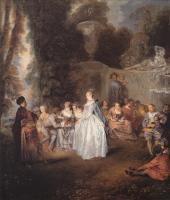Jean-Antoine Watteau
Watteau was born in Valenciennes, a town near the Flemish border which had recently become French. From a very early age he was passionate in his love of drawing and studied art in his native town. In about 1702 he moved to Paris, where he earned a meagre living as a hack painter, and a few years later went to work for Claude Audran, the curator of the Luxembourg Palace; through him and subsequent connoisseurs and collectors he had access to some of the work of Rubens, for whom he developed an enormous admiration, although his own style was always more introverted and poignant than that of the energetic Rubens.
Watteau’s paintings have all the delicacy and prettiness of the Rococo movement of the early eighteenth century, which followed the age of Baroque. It began in France after the death of Louis XIV in 1715, and spread to Southern Germany and Austria in the next forty years.
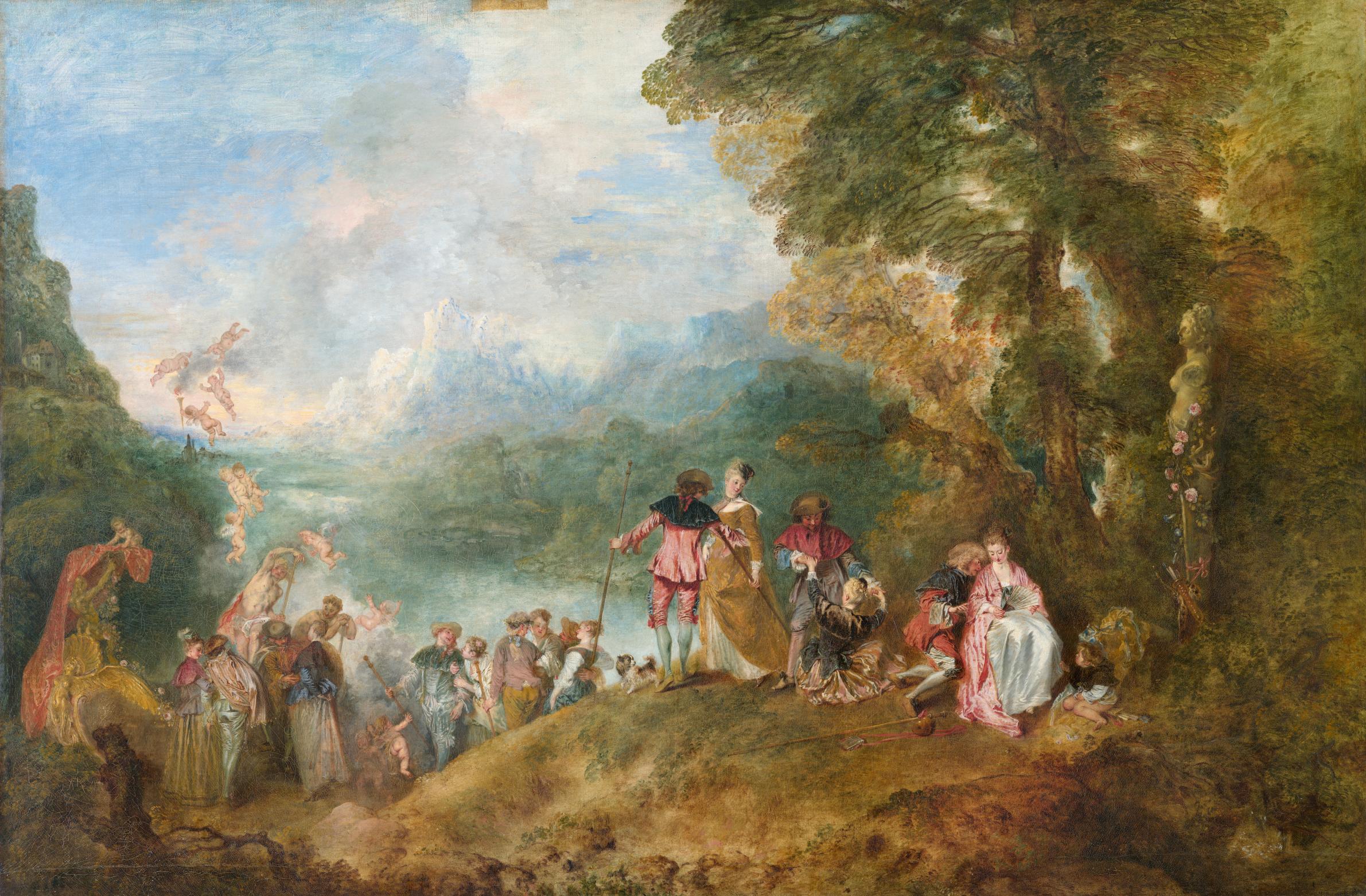 He disliked working for patrons on commission, and most of his pictures seem to
have been created at his own whim, and paid for by clients in advance or bought
by art dealers. Even the subject of this painting, The Embarkation for Cythera,
which he was asked to create for his formal admission to the French Royal
Academy, was left to his discretion, instead of being stipulated as was
generally the case. As a result, Watteau was able to add a new classification
to French art : the fete galante , pictures which, like Giorgione’s, take a
mood as their subject. It was a romantic mood in which the pleasures of the
senses and the fulfilment of the emotions were pursued with a gentle ardour in
idealized country settings.
He disliked working for patrons on commission, and most of his pictures seem to
have been created at his own whim, and paid for by clients in advance or bought
by art dealers. Even the subject of this painting, The Embarkation for Cythera,
which he was asked to create for his formal admission to the French Royal
Academy, was left to his discretion, instead of being stipulated as was
generally the case. As a result, Watteau was able to add a new classification
to French art : the fete galante , pictures which, like Giorgione’s, take a
mood as their subject. It was a romantic mood in which the pleasures of the
senses and the fulfilment of the emotions were pursued with a gentle ardour in
idealized country settings.
It is thought that The Embarkation for Cythera was inspired by a play in which two lovers make a pilgrimage to the island of Cythera off the coast of Southern Greece, the island which Venus may have reached at the moment of her birth from the sea. In Watteau’s painting the statue of Venus is garlanded with flowers, and the shell motif on the golden barge is another reminder of her birth. Little winged putti , symbols of love, drift over the sea. Peasants, villagers and courtiers are wending their way down to the water’s edge to board the barge, and others on the bank are rising to join them. In the centre a woman looks back with a tender smile, and her elegant, amorous cavalier, his arm about her waist, gently urges her to join the procession.
The hazy landscape is idyllic in the evening sun, and filled with an atmosphere of love and flirtation. We cannot be sure if the couples are embarking on the journey to Cythera, or if the mood is one of sweet regret that the day on the island of love is over and they must return; but this exquisite painting has an atmosphere of wistful melancholy, implying the transitory nature of happiness and life itself. It reflects the restlessness of Watteau’s temperament and his striving after perfection; and it is one of the most haunting and delicate examples of French eighteenth-century art.
 Watteau may have painted this as a sign for a cafe owned by Belloni, an actor
who played the role of melancholic Pierrot from the commedia dell’arte.
Contrasting the gravity of Gilles with the boisterous group behind him, Watteau
sets him apart in a colourless world of his own. By this time, Watteau was
quite ill with tuberculosis and possibly very sensitive to the certainty that
all the world’s pleasures are transient.
Watteau may have painted this as a sign for a cafe owned by Belloni, an actor
who played the role of melancholic Pierrot from the commedia dell’arte.
Contrasting the gravity of Gilles with the boisterous group behind him, Watteau
sets him apart in a colourless world of his own. By this time, Watteau was
quite ill with tuberculosis and possibly very sensitive to the certainty that
all the world’s pleasures are transient.


